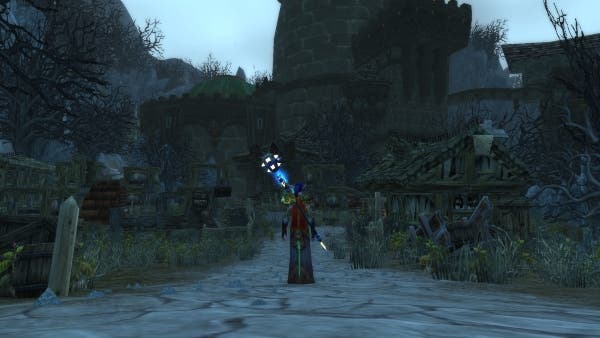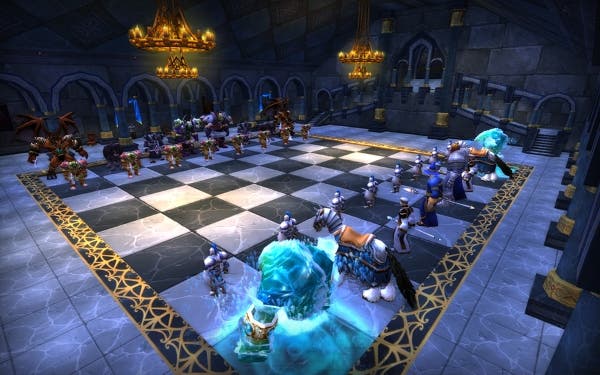Learning to raid: in praise of WOW's finest dungeon
The Karazhan of love.
World of Warcraft turned ten on Sunday, and all throughout this week we'll be marking the anniversary with a series of features from across Eurogamer's editorial team. Today, John reminisces on the game's early raiding scene, and pays tribute to one of Blizzard's greatest dungeons.
There were two paths ahead of you if you wanted to sample WOW's end-game raiding scene prior to the release of the game's first expansion. First, there were the cavernous zones such as Molten Core, designed for guilds large enough to field 40 players against the game's most monstrous creations. More accessible on paper - yet arguably less forgiving in practice - were the 20-player affairs like Zul'Gurub, the dense tropical jungle filled with poison and panic.
The Burning Crusade expansion shook things up by introducing an upper limit of 25 players for all raiding content. This transition towards tighter and more focused group combat was a double-edged sword, however. Raiding certainly became more accessible for players like me who existed outside of the largest guilds, but established raiding communities suffered a blunt mathematical division within their ranks.
That the first step towards the expansion's final showdown began with another mathematically inconvenient 10-player raid didn't help much, but taken on its own merits the Karazhan raid is arguably the finest dungeon in WOW's history. A grim edifice of stone and spire, set in the gloomy Deadwind Pass region of the world, Karazhan was a sprawling feast of exploration and intrigue, magic and enchantment, and the dead and undying.
Even passing through the door of this imposing building represented an adventure all by itself. Having quested through the Outlands continent in pursuit of WOW's new maximum level, there was a series of steps that had to be completed before an inquisitive dungeoneer could even enter this house of horrors. As well as working through a chain of quests, you also had to loot fragments of a key from a handful of end-game dungeons, before successfully finishing a nerve-shattering race against the clock in the Black Morass instance.
Established raiding guilds would have had little trouble funnelling its members efficiently through Karazhan's front door, of course, but for the complete newcomer it represented a delicious collection of irresistible micro-goals, each one a minor accomplishment in its own right. In an age before WOW's Dungeon Finder could be used to efficiently unite players in pursuit of a common goal, entry to Karazhan meant collaboration, community and enduring friendships.

It was worth every bit of effort to get inside though. Even when compared to WOW's largest early raids, Karazhan represented an enormous slice of content, packed full of intrigue, and with a genuine air of exploration as you and your friends teased your way through its corridors and side-passages.
A musty cellar provided bonus loot opportunities for those arriving early to the raid each week, while dusty libraries housed spiral staircases, ponderous wizards, intimidating arcane sentries, and apparitions fond of trapping those who dared to trail behind the pack. As you ascended the spires of the castle towards the dungeon's halfway point, a glance over one shoulder would reveal the extent of your party's vertiginous journey so far.
A fairground haunted house that takes itself too seriously is no kind of haunted house at all, and Karazhan embraced silliness and spookiness with equal aplomb. Once through that locked entrance, prancing harpsichord licks would ripple throughout the soundtrack, as you sneaked around ghostly ballroom dancers. A wandering groundskeeper would wonder out loud just what on earth all the commotion was about, while you simultaneously hacked the head off a spectral horse right next to him. Every ounce of gloom was artfully offset with a solid pound of the colour and vibrancy that defines WOW elsewhere.
Even though there were few duff fights to be found in Karazhan, there were a handful of truly unique encounters that still linger in the memory nearly eight years later. The Opera Event in particular, set on the crumbling castle's theatre stage for the benefit of a ghostly audience, randomly offered the raiding team one of three very different fights each week. Whether you faced off against the Big Bad Wolf, Dorothy and her friends, or the stricken lovers Romulo & Julianne, there was a frisson of uncertainty surrounding each fresh attempt at beating the dungeon. (The savvy raiding group soon learned to throw a naked Rogue behind the curtain, and have them sneak in undetected to discover each week's tale without inflicting expensive damage to their equipment).
After a series of increasingly tricky boss fights, your party would be challenged with taking control of a chess board, and engaging in a warped, third-person match against a ghostly gamemaster with a penchant for cheating. It was chaotic, confusing and entirely unexpected within WOW's established combat structure. The same instinct for imagination and experimentation that was lavished upon Karazhan has been touched upon in subsequent raids, but never with such creative confidence and exuberance.

If Karazhan is remembered less fondly by more hardcore raiders, it's a symptom of the blunt gating that formed the foundation of end-game progression in The Burning Crusade. Too often a raiding guild - desperately in need of fresh blood as expansion burnout crept in - would find itself forced to run new members through this once refreshing content, now fatigued beyond measure, just to gain access to the next in a long line of further gates. Karazhan unfairly became the poster child for a broader design shortcoming, rather than a moment of creative triumph for WOW's world-builders.
Whatever Karazhan came to mean to you towards the end of the expansion, it deserves to be remembered for its visual majesty and mischievous sense of mystery; for the blinding invention of its architecture, and for the bosses that seemed to lie around every exquisitely crafted corner. Remember and celebrate too those forehead-slapping moments when a friend trod less gingerly around the edges of the spectral ballroom, and brought a feast of phantoms raining down on everyone's head.
Remember Karazhan for all the right reasons, in other words, and hope that one day we get to tiptoe around another raiding experience even half as fine.









